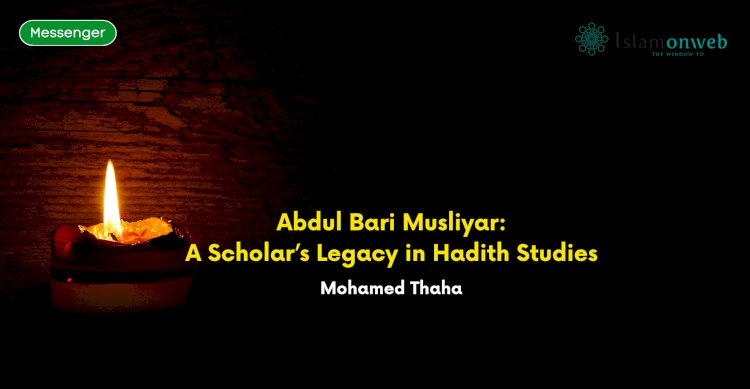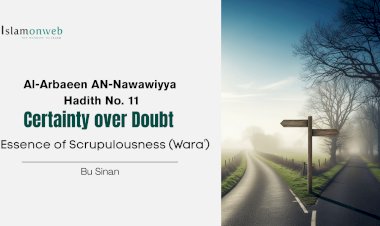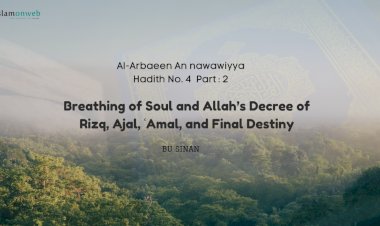Abdul Bari Musliyar: A Scholar's Legacy in Hadith Studies
The Qur'an and Hadith are complementary sciences that have coexisted throughout history and contributed to the sociocultural forms and awakening of the Muslim Ummah. Thus, an investigation into the origins of Hadith studies in Kerala naturally led to an analysis of the importance of Qur'anic studies in the area. Malik bin Dinar[i] and his associates may have had a more significant role than only building the first mosques. However, the Hadith had been passed down orally among the early converts in the area. Based on these premises, it is thought that there existed a sociocultural relationship between Arabs and Malabar, which appropriately served as a conduit for the dissemination of Hadith in Kerala.
Reviewing the early Hadith study centers in Kerala, the 20 mosques built by Malik bin Dinar's early missionaries serve as the initial point of reference. In addition to them, the large Ponnani mosque, constructed in the sixteenth century A.D by Shaikh Zainuddin al Kabir al Ma'bar[ii] (871-928 A.H.), had a significant impact in teaching and propagation. Ibn Batuta (d. 368 A.D) is recalled in this regard for having met several foreign academics and pupils in Malabar, including those from Syria, Baghdad, Yeman, Makkah, Madinah, Malaysia, Singapore, and Sri Lanka. During the reign of Abdullah bin Abdur Rahman, who was the disciple of Ahmed bin Abdul Qadir, in the late 12th and early 13th centuries, the Keralite community was impacted by the hadith tradition.[iii] A significant component of the Dars method of education, the study of Hadith covered an in-depth analysis of the text, which is relevant when taking into consideration the Hadith learning process in mediaeval academic institutions. By the second part of the 20th century, the Hadith had been widely circulated through Arabic and Shariah colleges. Additionally important to the children's learning of Hadith was the curriculum that was implemented in Madrasas.
Abdul Bari Musliyar’s Pioneering Work in Hadith and Sihahu Al-Shaykhain
Several prominent scholars have passed away in the state of Malabar, Kerala, who made significant contributions to the field of Hadith. Among them was the great scholar Shaykh Abul Haq Muhammad Abdul Bari Musliyar. He was one of the founding leaders of Samasta Kerala Jamiatul Ulema and a distinguished scholar who played a pivotal role in the organization's growth. Following the death of Pangil Ahmed Kutty Musliar, Abdul Bari Musliyar assumed the presidency and remained in that position until his passing.
He was born on 22 Jumadul Akhir 1298 AH, the son of Koyamutti Muslim Khaja Ahmad. In Puthuparamba, his father was a renowned leader and scholar. Abdul Bari Musliyar was born into an affluent and morally upright family. Despite coming from a wealthy background, he had a deep admiration for the Sufi Saints. His life served as a model for many. After receiving his elementary education from his father, he enrolled at Baqiyat Salihat Arabic College or Jami'ah al Baqiyath as Salihat for higher education after working as a teacher in Nadapuram, Tirurangadi, and Ponnani dars. Upon earning his degree in 1903, Baqavi returned home and started working as a teacher. He served as a Mudaris in Thanalur, Valavannur, and Kanancheri. While teaching at the former Jumu'at mosque in Valavannur, he also helped establish a curriculum based on the Sunnah Jamaat. He dedicated forty-five years of service to his native Pudhuparamb, from 1921 until his demise.
A significant financial contributor to Samasta's founding, Abdul Bari Musliar also made substantial financial investments in the group. With the establishment of Al Bayan magazine[iv] in 1929, he made significant sacrifices and gave purpose to its propaganda efforts. Abdul Bari Musliyar was an excellent writer who authored numerous essays for Al Bayan from its inception, covering topics such as Fiqh. Additionally, he possessed strong oratory skills and was fluent in Parsi, Urdu, and English. He initiated the recognition of Madrasas under the board of education, with Valakulam Puthuparam Bayanul Islam Madrasa being recognized as the foremost institution. The decision to establish Arabic colleges under Samasta was made by the committee chaired by Abdul Bari Musliar.
He authored many books covering various fields, among which are the collections Jam’u Al-Bari and Sihahu Shaykhain. Being particularly drawn to the Sunnat an-Nabawi, he wrote extensively on the compilation of Hadith. Jam’u Al-Bari encompassed diverse themes such as Fiqh, Hadees, Usul Al-Fiqh, and Quranic studies. Sheikh Abdul Bari's work has greatly benefited scholars. Given the authenticity of the Hadiths compiled by the revered Imam al-Bukhari and Imam al-Muslim, and their widespread acceptance among scholars and researchers, access to them is often required. Therefore, works like Misbah al-Sunnah are widely utilized in the field. Jam’u Al-Bari stands as a comprehensive collection of various sciences and studies.
Kitab Sihahu Shaykhain is one of his most significant works and also his final book. It comprises Hadiths of the Prophet (صلى الله عليه وسلم) agreed upon by Imam Bukhari and Muslim, as well as those unique to either of them. He was inspired by a Hadith of Prophet Muhammad (صلى الله عليه وسلم), which he included on the first page of his book"
بلغوا عني و لو آية[v]
Sheikh Abdul al-Bari compiled the content for his book "Sahāh al-Shaykhīn," along with its summary and abbreviation, from Sheikh Wali al-Din Abu Abdullah Muhammad's work "Mishkat al-Masābih." Abdullah al-Khatib al-Tabrizi structured it by integrating the hadiths from Imam al-Baghawi's book "Al-Mishāb" and expanding upon it with additional chapters.
Structural Analysis of Sihah Al-Shaykhyn
This book, the collection of Sihah Al-Shaykhyn, possesses its own uniqueness compared to other Hadith books. It contains only the agreed-upon Ahadith of both Imam Bukhari and Imam Muslim. It seems to readers that the Sheikh compiled this book summarily from the book “Mishkat al-Masabih” by Al-Khatib Al-Tabrizi, but Al-Tabrizi included in it the Hadiths of both Imam Bukhari and Imam Muslim, as well as those of others. Abdul Bari chose the Hadiths of the two Sheikhs, whether they concurred or were narrated by one of them alone. After praise and prayer, the Sheikh stated that this is a comprehensive book of the Sahihs of the two Sheikhs, organized by books, chapters, and the three categories usually found in those books.
In the first Fasl (chapter), Abdul Bari Musliyar only collected the agreed-upon Ahadith of both Imam Bukhari and Imam Muslim. In the second Fasl, he collected those Hadiths that Sheikh Muhammad al-Bukhari was alone with, and in the third Fasl, he collected those Hadiths that Sheikh Muslim al-Nisaburi agreed upon alone. While Al-Mishkat contains 6285 Hadiths, this book contains 2647 Hadiths. He started his book with that authentic Hadith which every Muhaddthin will start:
حديث إنما الأعمال بالنيات[vi]
He also included unique chapters from the Mishkat, excluding those without the Sahih, in which he divided these books into multiple chapters, aligning with the chapters in Sihah al-Shaykhin. This arrangement mirrors that of the Mishkat itself, although he omitted some chapters present in it, as Al-Khatib al-Tabrizi did not mention them. The book comprises a selection of prophetic Hadiths organized according to the sequence of jurisprudential chapters. Unfortunately, the remaining original copies were kept in ancient Mosque Libraries but were not properly conserved, leading to deterioration and damage by moths. "Kitaf Thimar al-Mulakhain fi Sharh Sihah al-Shaikain" (قطاف ثمار الملخين في شرح صحاح الشيخين) is a biography and explanation of Sheikh Abul Haq Muhammed Abdul Bari Al Malaibari's work "Kitab Sihah al-Shaykhin," written by Prof. Dr. Bahauddeen Muhammed Jamaluddeen Nadwi.
References
Abdul Bari Musliar. n.d. "Keralam Panditha Pramughar Abdul Bari Muslyar." Islam Kavadam. Accessed [date]. https://www.islamkavadam.com/prasthanam/keralam-panditha-pramughar-abdul-bari-muslyar.
Hanafi, Muhammad Idris Al Kandelvi As Siddiqi Al. 1935. *At Taliq As Sabih Ala Mishakat Al Masabih.* Digital Library Of India.
Ishaq, Muhammad. 2012. "India's Contribution To The Study Of Hadith Literature." PhD diss., University of Dacca.
Nadwi, Dr. Bahauddeen Muhammad Jamaluddeen. 2016. *قطاف ثمار الملخين في شرح صحاح الشيخين.* Malapuram.
Nadwi, Shaykh Abu’ l-Hasan ʿAli al-Hasani. 2012. "How Hadith Came to India." IlmGate.
P, Sakkeer Hussain. 2010. "Development of Islamic Studies in Kerala." PhD diss., Department of Islamic Studies.
Rashid, Dr. Rafaqat. 2018. "Evaluation of Mishkat Al-Masabih as a Source Book of Hadith and Islamic Jurisprudence." January 31.
Sayeed, Asma. 2023. "Hadith." Britannica. Accessed [date]. https://www.britannica.com/biography/al-Bukhari.
Siddiqi, Dr. Muhammad Zubayr. n.d. "Hadith Literature." PhD diss., Calcutta University.
أنس سي تي. 2014. "النشاطات الحديثية في كيرلا." Master's thesis, Jamia Dar Al Huda Al Islamiyah, India.
About the author
Mohamed Thaha, Chennai, Tamil Nadu. PG scholar, Department of Quran and Related Sciences, Darul Huda Islamic University, Kerala.
Endnotes
[i] He was the known to be the first Muslim to propagate Islam in India. He was buried at Kasargood.
[ii] Famous author of Fat'h Ul Mueen, and Thuhfathul Mujahidin.
[iii] Yaqut al Hamawi (1179-1229A.D), a noted historian, has mentioned, Development of Islamic Studies in Kerala during 18th to 20th century, pg:121.
[iv] An Arabi-Malayalam Magazine, Abdul Bari Musliyar was the editor of this Magazine. Since 1954.
[v] هذا صحيح رواه البخاري في صحيحه(3461) الراوي : عبدالله بن عمرو
[vi] عن أمير المؤمنين أبي حفص عمر بن الخطاب رضي الله تعالى عنه هذا حديث صحيح متفق على صحته
Disclaimer
The views expressed in this article are the author’s own and do not necessarily mirror Islamonweb’s editorial stance.
























Leave A Comment